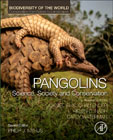
Pangolins: Science, Society and Conservation
Challender, Daniel W.S.
Nash, Helen
Waterman, Carly
Pangolins: Science and Conservation brings together experts from around the world to document the most up-to-date scientific knowledge on pangolins and their conservation. It chronicles threats facing the species, current initiatives being implemented to protect them, and looks ahead at the future of pangolin science and conservation efforts. Led by a team of editors recognized as pangolin specialists, this book includes accounts of the species' evolution, morphology, phylogeny and taxonomy. In addition, it discusses the role of pangolins in historically symbolic, mythological and ritualistic practices across Africa, Asia and Europe, also exploring contemporary practices, such as illegal international trade. Chapters in the latter portion of this book focus on the conservation, rehabilitation, and legal regulation of pangolins around the world, including current political efforts and interventions to secure the future of the species. Provides natural history and current conservational statuses for each of the eight pangolin speciesExplores the cultural significance of pangolins, from historic, to contemporary use Presents information on international pangolin tradeDiscusses practices and solutions for veterinary health, diets and husbandry of pangolins in captivity INDICE: Foreword Preface Acknowledements PART ONE: WHAT IS A PANGOLIN? 1. Evolution and morphology 2. Phylogeny and taxonomy 3. Symbolism, mythology and ritual significance of pangolins in Africa and Asia 4. Early biogeographies and symbolic use of pangolins in Europe in the 16th-18th centuries PART TWO: NATURAL HISTORY, STATUS AND THREATS 5. Chinese pangolin Manis pentadactyla 6. Indian pangolin Manis crassicaudata 7. Sunda pangolin Manis javanica 8. Philippine pangolin Manis culionensis 9. Long-tailed pangolin Phataginus tetradactyla 10. Tree pangolin Phataginus tricuspis 11. Giant pangolin Smutsia gigantea 12. Temminck's Ground pangolin Smutsia temminckii PART THREE: CULTURAL SIGNIFICANCE AND UTILISATION 13. Meat and medicine: historic and contemporary use in East Asia 14. Hunters and hobbyists: historic and contemporary use in Southeast Asia 15. Historic and contemporary use in South Asia 16. Bushmeat and beyond: use in West and Central Africa 17. Rituals and rainmaking: use of pangolins in East and Southern Africa 18. International trade in pangolins, 1900-2018 PART FOUR: EX SITU CONSERVATION, REHABILITATION, AND SUPPLY-SIDE INTERVENTIONS 19. A history of pangolins in captivity 20. Pangolins in zoos: defining the role of ex situ conservation 21. Husbandry of pangolins: lessons and challenges 22. Captive pangolin diets 23. Veterinary health and pangolins 24. Lessons from rescue, rehabilitation and release 25. Challenges of dealing with trade-confiscated pangolins 26. Evaluation of farming as a conservation solution PART FIVE: CONSERVATION SOLUTIONS Law enforcement and regulation 27. The role of enforcement and regulation of harvest and trade 28. Securing pangolin conservation in Zimbabwe [case study] 29. Addressing trade threats to pangolins in CITES 30. Understanding illegal trade through forensics Awareness raising, behaviour change, and community engagement 31. Raising awareness of pangolins locally, nationally and globally 32. Changing consumer behaviour for pangolin products 33. Engaging local communities in responses to illegal pangolin trade 34. Community conservation in Nepal [case study] 35. Holistic approaches to protecting a pangolin stronghold in Central Africa [case study] Conservation planning and research 36. Setting priorities for conserving pangolins 37. Research needs for pangolins 38. Developing robust field methodologies 39. Identifying and protecting strongholds 40. Leveraging support for pangolins through innovative finance, conservation tourism and other means The future 41. Taking pangolin conservation to scale: the IUCN SSC Pangolin Specialist Group and the next 20 years
- ISBN: 978-0-12-815507-3
- Editorial: Academic Press
- Encuadernacion: Cartoné
- Páginas: 532
- Fecha Publicación: 01/09/2019
- Nº Volúmenes: 1
- Idioma: Inglés
